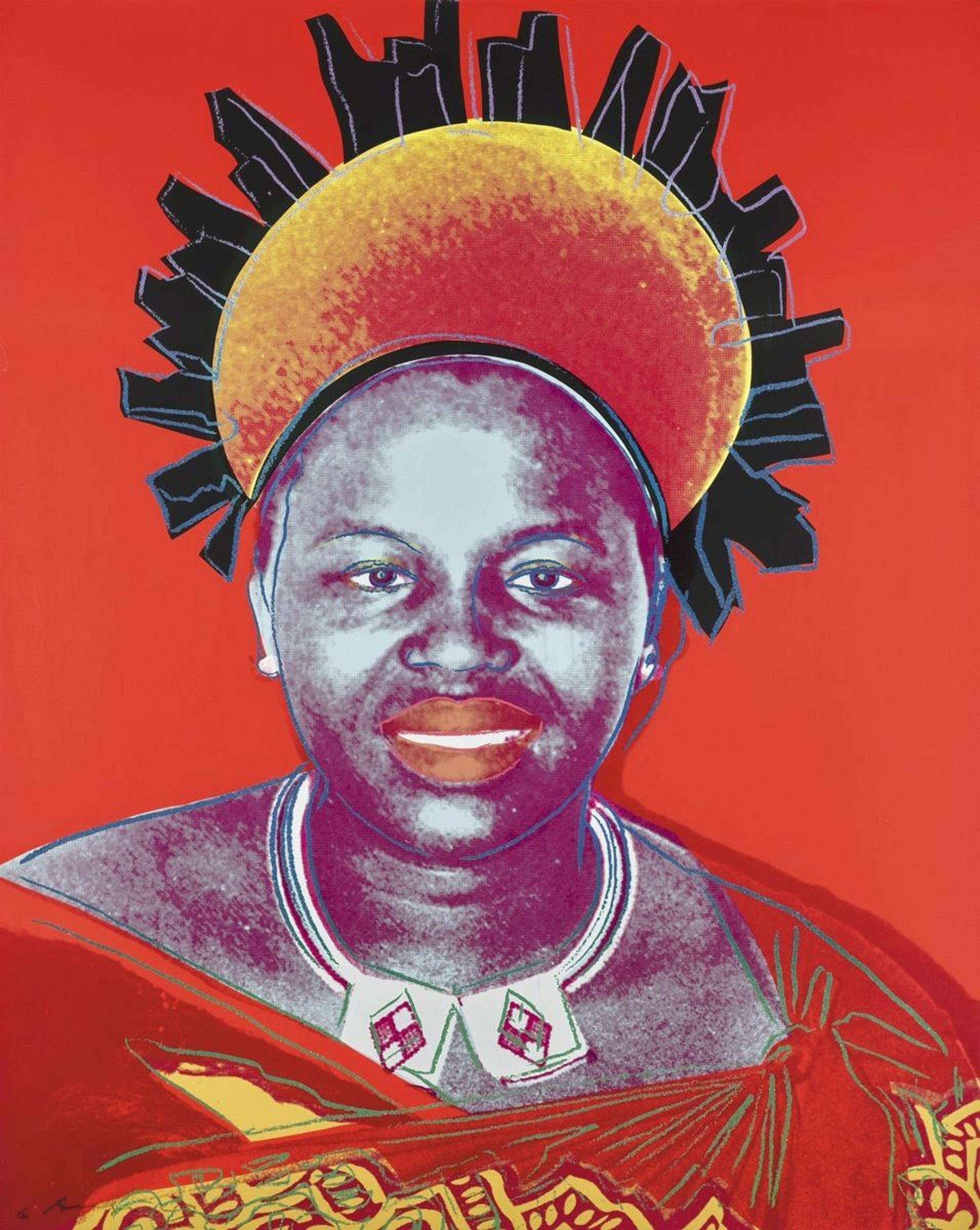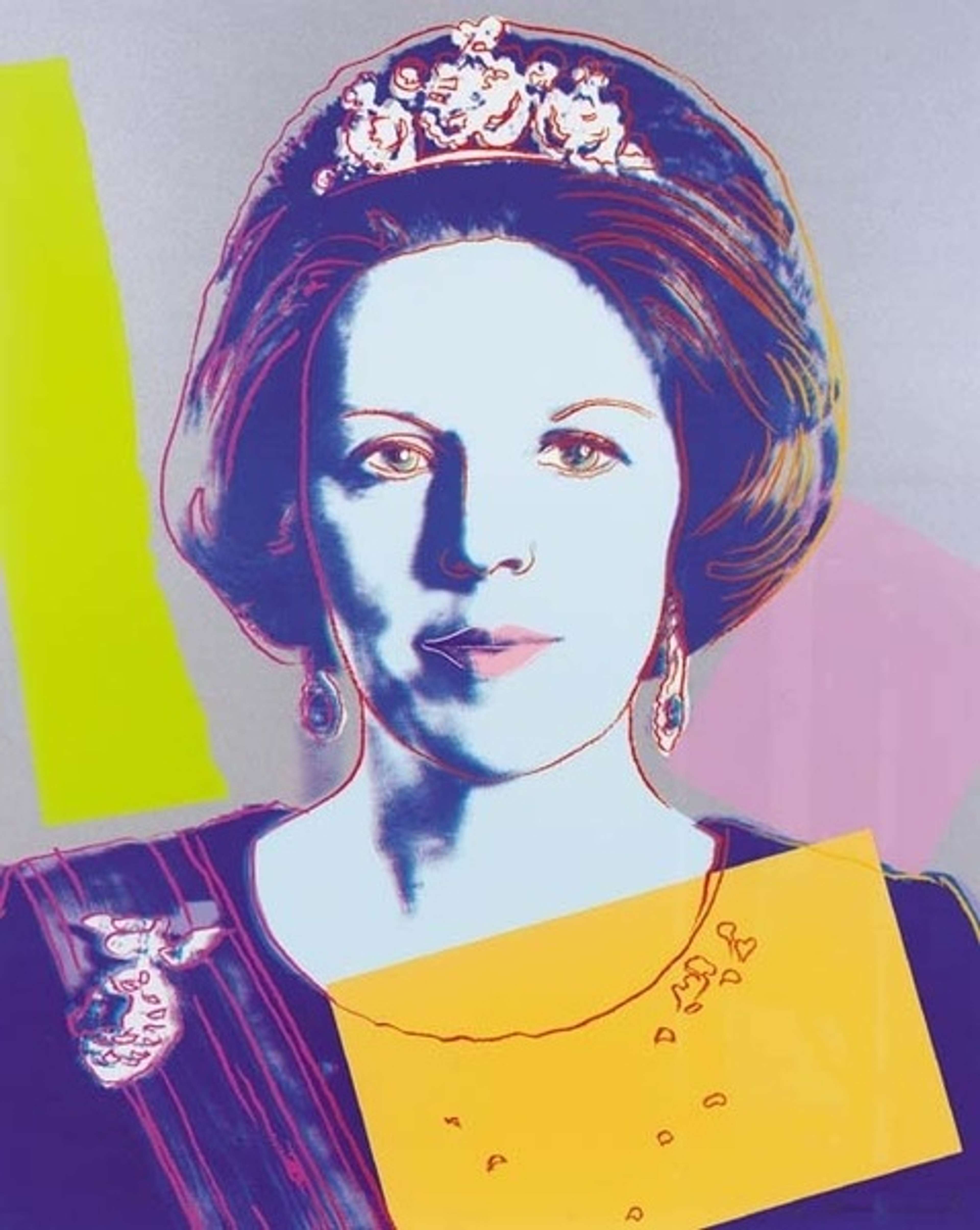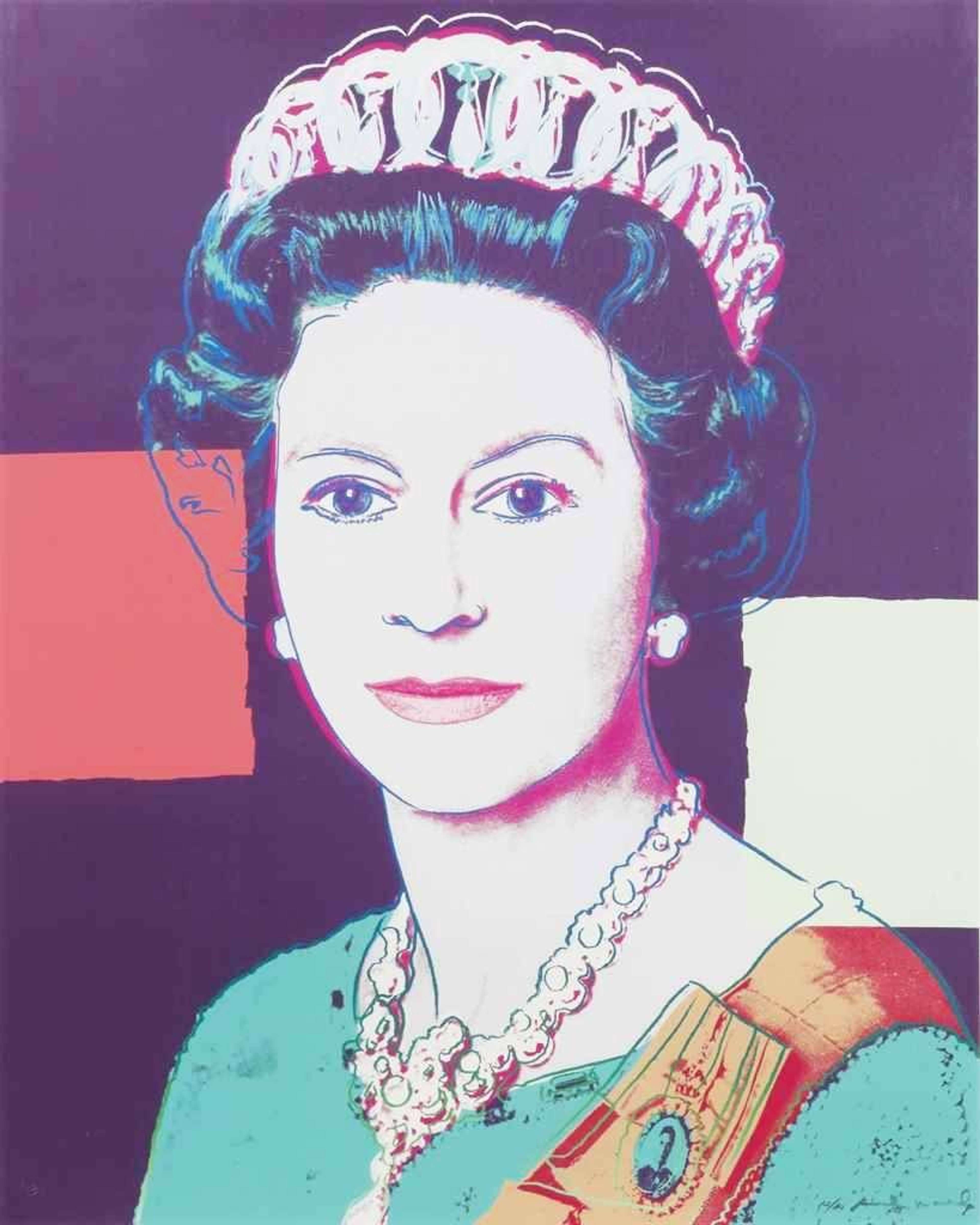 Queen Elizabeth II (F. & S. II.334) © Andy Warhol 1985
Queen Elizabeth II (F. & S. II.334) © Andy Warhol 1985
Interested in buying or selling
Andy Warhol?

Andy Warhol
487 works
From the early days of his career, Andy Warhol challenged notions of fame and high and low culture. Drawing its subject matter directly from mass media imagery, Warhol's Reigning Queens series created in 1985 offers a bold commentary on celebrity culture.
The series depicts four queens who ruled in 1985.
 Queen Ntombi Twala Of Swaziland (F. & S. II.349) © Andy Warhol 1985
Queen Ntombi Twala Of Swaziland (F. & S. II.349) © Andy Warhol 1985Andy Warhol's Reigning Queens series consists of 16 prints depicting Queen Elizabeth II of the United Kingdom, Queen Ntombi Twala of Swaziland, Queen Beatrix of the Netherlands and Queen Margrethe II of Denmark.
The Reigning Queens series is based on photographs.
 Queen Elizabeth II Royal Edition (F. & S. II.336A) © Andy Warhol 1985
Queen Elizabeth II Royal Edition (F. & S. II.336A) © Andy Warhol 1985The 16 prints are based on official media photographs. Each of them features abstract chunks of colour that appear collaged but were screen-printed by the artist. To emphasise details such as the queens' jewels, Warhol incorporated printed elements from drawings to the works. Prints depicting Queen Elizabeth II were based on the official photograph taken by Peter Grugeon at Windsor Castle on 2 April 1975, and released for the Silver Jubilee in 1977.
The series captures the importance of photography in Warhol's creative practice.
 Queen Beatrix Of The Netherlands (F. & S. II.340) © Andy Warhol 1985
Queen Beatrix Of The Netherlands (F. & S. II.340) © Andy Warhol 1985The portraits of the Queens capture how photography became a point of departure in Warhol's experimental practice. Based on photographs, the prints confront the viewer with bold variations of one and the same image. As such, the use of photographs allowed Warhol to get to the core of the politics of mass production and artifice underlying public images.
The Reigning Queens series challenges our understanding of authority and fame.
 Queen Elizabeth II (F. & S. II.334 - 337) (complete set) © Andy Warhol 1985
Queen Elizabeth II (F. & S. II.334 - 337) (complete set) © Andy Warhol 1985The Reigning Queens series addresses the idea of idealized femininity created by modern media. The prints, with their exaggerated colours and abstract shapes, transform the appearance of each Queen. Warhol's take on the royal subject matter problematizes contemporary images of authority and fame. It exposes both the artifice of modern media and its alluring nature. Warhol's intention that the prints should be displayed as multiples demonstrates his interest in the problems of modern-day mass production.
The method of reproduction is central to the Reigning Queens series.
 Queen Margrethe Of Denmark (F. & S. II.343) © Andy Warhol 1985
Queen Margrethe Of Denmark (F. & S. II.343) © Andy Warhol 1985The method of reproduction is key to Warhol's representation of regal figures whose images featured extensively on stamps, currency and in the media. The method of reproduction offered Warhol a powerful means to reflect how fame can turn public image into a commodity.
The series plays with the recognisability of public images.
 Queen Elizabeth II (F. & S. II.334) © Andy Warhol 1985
Queen Elizabeth II (F. & S. II.334) © Andy Warhol 1985Warhol's choice to feature Queen Elizabeth II in the series is strongly related to the fact that she is among the most depicted women in the world. The context of the Queen's fame creates a powerful point of departure to question the cult of celebrity and allure of public images. Reproduced four times in the series, the image of Queen Elizabeth II draws a fine line between provocation and reverence.
To proceed with the series, Warhol needed permission to use Queen Elizabeth's portrait.
 Queen Elizabeth II (F. & S. II.335) © Andy Warhol 1985
Queen Elizabeth II (F. & S. II.335) © Andy Warhol 1985On the 6th of September 1982, Andy Warhol's dealer George Mulder wrote to the monarch’s private secretary, Sir William Heseltine, asking for a permission to use the Queen’s portrait in the series. Heseltine wrote back that "the Queen would certainly not wish to put any obstacles in Mr Warhol’s way," however "she would not dream of offering any comment on this idea".
Celebrity and fame are Warhol's most central motifs.
 Marilyn (F. & S. II.31) © Andy Warhol 1967
Marilyn (F. & S. II.31) © Andy Warhol 1967Since the early days of his career, Andy Warhol has been fascinated with popular culture and the phenomenon of modern-day celebrity life. It is both the alluring nature of fame and a sense of its superficiality that inspired the artist's engagement with images of public personalities, such as Marilyn Monroe or Elizabeth Taylor.
Reigning Queens echoes the style of the Ladies and Gentlemen series.
 Ladies And Gentlemen (F. & S. II.130) © Andy Warhol 1975
Ladies And Gentlemen (F. & S. II.130) © Andy Warhol 1975Abstract shapes and blocks of bold colours overlap with the likenesses of sitters in both Reigning Queens and Ladies and Gentlemen, creating an unexpected link between the two series.
Although their subject matter differs significantly, Reigning Queens shares a strong visual affinity with Ladies and Gentlemen. Warhol's earlier series was dedicated to Black and Hispanic drag queens from The Gilded Grape, a nightclub in Greenwich village. The 1975 series is controversial in that it engages with the experience of Black and Latinx trans communities, while keeping each individual's identity anonymous. The series remains controversial as Warhol himself was not part of this community, and despite being commissioned $1 million to produce the artworks, he only paid his sitters $50 per hour.
The prints from the Royal Edition were sprinkled with diamond dust.
 Queen Margrethe Of Denmark Royal Edition (F. & S. II.342A) © Andy Warhol 1985
Queen Margrethe Of Denmark Royal Edition (F. & S. II.342A) © Andy Warhol 1985The series was released in two editions of varying colours. The ‘Royal Edition’ consisted of 30 prints, and the ‘Standard Edition’ of 40. The Royal Edition prints were adorned with fine particles of crushed glass that shined in the light like diamonds.
